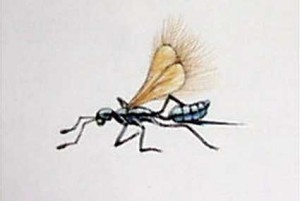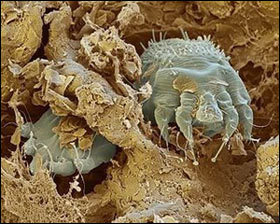How Small is the Smallest Insect?
The smallest insects currently known are the fairy flies,  which measure 0.2 to 0.4 mm. These are not actually flies; they belong to the wasp family (Hymenoptera).
which measure 0.2 to 0.4 mm. These are not actually flies; they belong to the wasp family (Hymenoptera).
Characteristics of the Fairy Flies
The fairy flies are included in the Chalcidoidea family and classified as non metallic. There are over 1,400 species of fairy flies of varying sizes. There are 100 genera. The smallest are the male Alpus magnimius which measure 0.21 mm. The wingspan dimensions also vary but the largest measure 3 mm.
Distribution of these insects is worldwide (New Zealand alone has 160 species). Most of the world’s smallest insects are situated in high altitude places. One reason for their wide distribution is the wind; their size makes them susceptible to the flows and ebbs of the currents.
Reproduction and Male / Female Traits
Females are bigger than the males and more adept at flying. Several fairy flies can swim underwater, using their wings as paddling devices. It has been suggested that mating and egg laying actually takes place in the waters. Some species can last up to two weeks underwater. They don’t fly out of the water; the insects climb plant stems.
Fairy flies have numerous hosts. The eggs of grasshoppers, aphids, lice and beetles are among the most frequent hosts of the world’s smallest insects. Cicada eggs are also common hosts. In many countries, fairy flies have been used to parasitise insects that consume on Eucalyptus.
A proper program could make fairy flies into helpful parasites. Several programs have been conducted in North America, South America and in many countries in Europe. Pupation occurs within the host’s egg shell. From the eggs the adults emerge.
Given their size, it’s not surprising that little information about these insects is known. They can be difficult to find. It should also be noted no sub families are known.
This doesn’t mean that none exist; further research will shed light on it. With so much still to be learned, more work by professional and amateur naturalists is needed.
Other Candidates for the World’s Smallest Insects
Although fairy flies are considered the smallest, other species are regarded as serious contenders. Some species of beetles are less than 0.5 mm in length. The Feather-winged Beetle Nanosella fungi (in North America) measure 0.25 mm.
The fly (Diptera) family includes several members that are also less than 1 mm long. The Collembia (Springtails) are also very small. Some researchers believe that the feather wing beetles and the Megaphragma caribea (a hymenopteran parasite) are even smaller than the fairy fly.
There are also some insects that are even smaller than protozoa. Protozoa are single cell creatures. The Tanzanian parasitic Wasp is regarded as the tiniest winged insects. The wingspan is less than 0.3 mm. There are also several insect orders and families that have very small members.
The title of the world’s smallest insects may be held by the fairy flies, but no one knows how long that will be. With scientific instruments improving, even tinier insects may be discovered.





